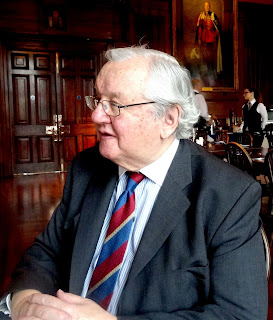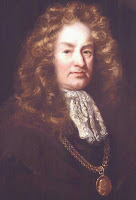 |
| Nigel Armstrong-Flemming. All photos by JT Marlin. |
A few weeks later he kindly introduced me to Windsor Herald, an officer of arms at the College of Arms, also known as the College of Heralds.
The office of Windsor Herald is older than the College of Arms itself. It was reportedly created by Edward III in 1364 when a Pursuivant of Edward brought him news of the British victory at Auray. He was rewarded by promotion to Herald with the title Windsor.
------------------
Celebratory Note: My article in Oxford Today on the Oxford colleges' coats of arms may be found here.
-------------------
In 1419, Windsor Herald was sent to the Duke of Brittany and has been maintained since then. The badge of office is the sunburst badge of Edward III royally crowned.
 |
| William George Hunt, Windsor Herald, out of uniform, at the Armoury House in London. Photo by JT Marlin. |
Ashmole gave his extensive library to Oxford, which in return put his name on its museum, now the Ashmolean Museum (newly renovated and not to be missed, opposite the Randolph).
Windsor Herald today is William George Hunt, TD, BA (Southampton), FCA. We met at lunch at the historic Armoury House in London.
He then gave me a tour of the College of Arms, abbreviated by the fact that the library area is being renovated.
The College corporation is overseen by the Earl Marshal, a hereditary office held by the Duke of Norfolk, currently Edward Fitzalan-Howard, 18th Duke of Norfolk. The College is composed of 13 officers or heralds:
- Three Kings of Arms (Garter, Clarenceux and Norroy & Ulster).
- Six Heralds (Chester, Lancaster, Richmond, Somerset, Windsor and York).
- Four Pursuivants (Bluemantle, Portcullis, Rouge Croix and Rouge Dragon).
 |
| Elias Ashmole, by John Riley. |
In addition to these officers, seven officers extraordinary take part in ceremonial occasions but are not part of the College.
 |
| College of Arms, London. Photo by JT Marlin. |
 |
| Windsor Herald in the Library, being renovated, of the College of Arms. |
The grant of arms certifies that the coat of arms is original and the College of Arms is ready to help stop someone else from using it, e.g., in a civil suit.
Before a grant is made, it is preceded by painstaking research to ensure that no one else has previously used such a coat of arms.
Scotland has its own independent heraldic authority, the Court of the Lord Lyon. Use of arms in Scotland is governed by criminal law and, for example, marks of cadency (for younger sons) must be used to insure that each coat of arms is unique to an individual.
Windsor Herald and other heralds have a skilled staff including the Poursuivants (apprentice heralds) and historic resources, including categorizations by type of "device" on huge numbers of coats of arms. The College of Arms is unusually well equipped to research a coat of arms before providing a design or a grant of arms.
It is a challenge to maintain these resources. The officers are appointed by the British Crown, which delegates authority to act on the Queen's behalf in all matters of
- heraldry and the granting of new coats of arms,
- genealogical research and the recording of pedigrees, and
- vexillogical questions, i.e., issues relating to the flying of flags on land and maintaining official registers of flags and other national symbols.
 |
| Note that all three Kings of Arms have signed this grant of arms, as is customary. |
The College of Arms also consults on the planning of many ceremonial occasions such as coronations, state funerals, the annual Garter Service and the State Opening of Parliament.
Heralds of the College accompany the sovereign on many of these occasions.
Heralds of the College accompany the sovereign on many of these occasions.
Though a part of the Royal Household of the United Kingdom, the College is self-financed, not supported by the British taxpayer. If you are thinking of adopting a coat of arms for family or institution, I urge you to go through channels and get a grant of arms. The grant fees, listed on the website of the College of Arms, are lowest, about $9,000 for an individual. The fee is higher for nonprofit institutions and is most expensive for profit-making corporations.
Founded 531 years ago (in 1484) by a royal charter from Richard III, the College is one of the few remaining official heraldic authorities in Europe. It has been located in the City of London since its foundation, and has been at its present address on Queen Victoria Street for 460 years (since 1555), which must be some kind of record.
Americans can contribute to support of the College of Arms through a Foundation administered by the New York Genealogical and Biographical Society. The foundation web site reports that it is registered as a 501(c)(3) corporation. I have made a modest gift to the foundation. To do the same, you can send dollar contribution checks, which are deductible from taxable income reportable to the IRS, to the Treasurer of the Foundation:
Robert W. Thompson, Treasurer
College of Arms Foundation, Inc.
58 Seneca Place
Oceanport, NJ 07757
No comments:
Post a Comment